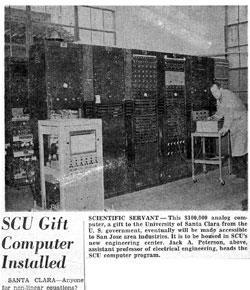Welcome to the Computer Age!
Though we take our smart phones, PCs, and iPads for granted today, it wasn’t all that long ago that computers were gigantic, card-sorting machines whose wonders were made available to only a tiny segment of the population.
In 1960 Santa Clara joined the computer age when it installed a 200 sq. ft. computer, referred to in a San Jose Mercury News article at the time as a “giant calculator.” The $100,000, 7 ft. tall computer was used for undergraduate and graduate projects as well as for faculty research.
By the mid-60s, the School of Engineering’s computer lab had grown to a fleet of 10 terminals connected to the University’s DEC computer. Alumni remember having to make a reservation to use the computer in the wee hours of the morning. A few years later, after instituting a $10 per student fee, Broncos enjoyed about as much computer power per student as any other school in the country.
As the 1970s approached, it was generally accepted that engineering students should have experience solving problems using a computer and the civil, electrical, and mechanical engineering departments began introducing model building, simulation, and optimization into their curricula.
Over the years, the computing power accessible to SCU engineering students has continually been upgraded and has always been top-notch, but as Ron Danielson, Vice Provost for Information Services and Chief Information Officer (and faculty member in the Department of Computer Engineering) notes, “The smartphones we carry around in our pockets these days have “more than 1000 times the processing speed (with a processor that does more with each instruction) and more than 1000 times the memory, in less than one ten thousandth of the space (0.0001), of the computer our students used when I came to campus in 1976.”
As we enter our second century of engineering excellence and celebrate more than 50 years of computing at SCU, the Engineering Design Center boasts three Windows, one Sun Solaris, 1 Centos Linux/Windows and one Mac lab in a 3400 sq. ft. facility providing the primary computing resources for instructional and research-related activities in the School of Engineering using an array of industry-standard technical software packages and a variety of programming language compilers. The School also houses and supports additional computer labs for the civil, mechanical, and electrical engineering departments.
